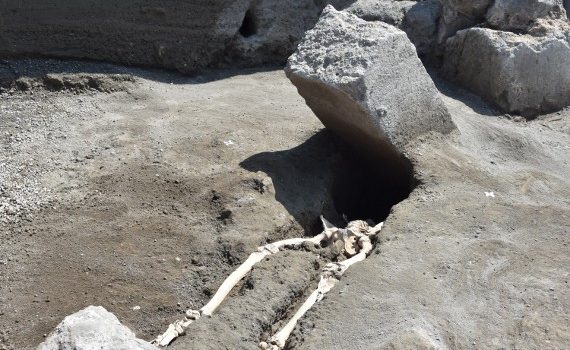FLEEING THE ERUPTION
CRUSHED BY A LARGE BLOCK OF STONE
THE FIRST VICTIM OF THE NEW EXCAVATION SITE EMERGES
The thorax was crushed by a large block of stone, and the body hurled back by the force of the pyroclastic flow, in a desperate attempt to flee the fury of the eruption. The first victim which emerges in the site of the new excavations of Regio V, does so in this dramatic position.
The skeleton was discovered at the crossroads of Vicolo delle Nozze d'Argento and the recently unearthed Vicolo dei Balconi, which extends towards Via di Nola. Initial observations would appear to indicate that the individual survived the first eruptive phase of the volcano, and subsequently sought salvation along the alley now covered in a thick layer of lapilli. The body was found at the height of the first floor of the adjacent building, and thus above the lapilli layer. Here he was struck by the dense pyroclastic flow which threw him back.
A formidable stone block (perhaps a door jamb), violently thrown by the volcanic cloud, collided with his upper body, crushing the highest part of the thorax and yet-to-be-identified head, which lie at a lower height of the lower limbs, and probably under the stone block.
The primary analyses, conducted by the anthropologist during excavation, have identified the victim as an adult male, over 30 years of age. The presence of lesions on thr tibia indicate a bone infection, which could have caused significant walking difficulties, enough to impede the man's escape at the first dramatic signs which preceded the eruption.
“This exceptional find, - declares Massimo Osanna - reminds us of an analogous case, that of a skeleton discovered by Amedeo Maiuri in the House of the Smith, and which was recently studied. These were the remains of a limping individual - he too was likely impeded in his escape by motor difficulties, and left exposed at the time in situ.
Beyond the emotional impact of these discoveries, the ability to compare them in terms of their pathologies and lifestyles as well as the dynamics of their escape from the eruption, but above all to investigate them with ever more specific instruments and professionalism present in the field, contribute toward an increasingly accurate picture of the history and civilisation of the age, which is the basis of archaeological research.
The new excavations of Regio V, where this extraordinary discovery took place, are part of the intervention to stabilise the excavation fronts within the ancient city, envisaged by the Great Pompeii Project. The archaeological excavations underway are focused on the area of the so-called 'Wedge', located between the House of the Silver Wedding and the House of Marcus Lucretius Fronto.


